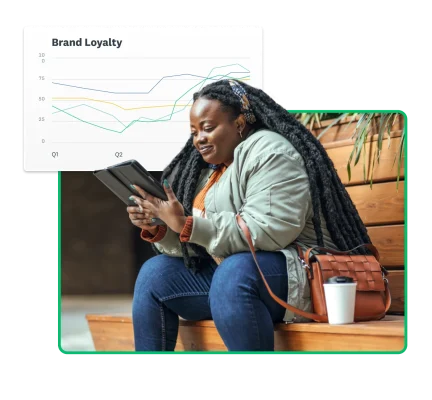How to measure brand loyalty: 11 key metrics to track
Learn how winning businesses measure brand loyalty with surveys.

Businesses globally measure brand loyalty to support customer retention, business growth, and new customer acquisition. An effective brand loyalty strategy helps companies to reduce customer churn and build a better brand reputation.
Brand loyalty is demonstrated when customers repeatedly purchase from a business instead of choosing competitors. Loyal customers will shop for a specific brand’s products over and over. More than ever, companies should focus on customer loyalty to build lasting relationships.
Not sure how to measure brand loyalty? This guide covers 11 metrics and best practices to know.
Why measuring brand loyalty matters
Measuring brand loyalty involves more than tracking the number of loyalty program sign-ups. It also involves identifying brand advocates to establish sustainable growth and profitability. Businesses should track brand loyalty in today’s competitive market to improve customer experiences and retention rates.
A McKinsey & Company study emphasized the importance of brand loyalty, revealing loyal customers are 64% more likely to make frequent purchases and 50% more likely to recommend the brand to others.
Tracking brand loyalty can give businesses valuable insights into customer behavior. Collecting and analyzing data empowers teams to optimize marketing strategies, improve product design, and drive higher revenue.
Measuring brand loyalty helps businesses in a myriad of ways, including:
- Enhance customer experience. Businesses can use insights from tracking brand loyalty to promote better customer experience.
- Improves customer retention. Brand loyalty is essential to improving customer retention and decreasing churn.
- Boosts brand reputation. Happy and loyal customers directly impact your brand’s reputation through word-of-mouth marketing and online reviews.
- Drives revenue growth. Over time, customer loyalty can significantly drive sales that result in revenue growth.
- Attracts new customers. Having loyal customers helps attract new customers to your brand by improving brand perception.
- Measure marketing effectiveness. Tracking brand loyalty aids teams in understanding if their marketing strategies are working effectively.
11 key metrics to measure brand loyalty
Brand loyalty can be measured in many ways, making it challenging for some businesses to know where to start. While you may not need to monitor all 11 metrics at once, it’s important to gather a combination of qualitative and quantitative data for deeper insights.
Businesses should use surveys as a primary method for collecting customer data when measuring brand loyalty. Surveys are simple to create and send and can be used to gather customer feedback. The data can then be analyzed to identify patterns, common pain points, and customer sentiment. Brands should track trends over time using the following metrics to see the long-term impacts of their brand loyalty strategy.
1. Net Promoter Score (NPS®)
Net Promoter Score is one of the most commonly used metrics for brand loyalty. It asks customers a single question: On a scale of 0 to 10, how likely are you to recommend our brand to friends or colleagues?
Customers are split into three groups based on their responses:
- Promoters (9-10) are the most satisfied customers who will likely recommend your brand.
- Passives (7-8) are neutral customers who haven’t had a negative experience but aren’t likely to recommend your brand.
- Detractors (0-6) are dissatisfied customers who will likely detract from your brand reputation.
To measure NPS, use this formula.
NPS = % of promoters - % of detractors
Businesses can also use this handy NPS calculator to determine their score out of 100. NPS is an efficient way to gauge customer loyalty over time. Since millions of businesses worldwide use NPS to measure customer loyalty, you can easily reference benchmarks. NPS offers a simple, fast, and actionable way to measure brand loyalty.
2. Customer retention rate
Customer retention rate measures the percentage of customers who stay for a specific period of time. It’s the inverse of customer churn, which measures the percentage of customers who stop doing business.
The formula for customer retention rate is:
Customer retention rate = ((End number of customers - New customers gained) / Starting number of customers) x 100
Customers come and go, but keeping them around is a valuable growth strategy. It is much more expensive to acquire new customers than to retain old ones. Studies show that acquiring a new customer can cost up to five to seven times more than keeping a current customer. To improve customer retention, focus on personalizing customer experiences and fostering brand engagement.
3. Customer Lifetime Value (CLV)
Customer lifetime value measures the value a customer is worth throughout their entire relationship with a business. It is the estimated amount of money a customer spends from when they are first acquired to when they stop doing business with a brand.
Use this formula to measure customer lifetime value:
CLV = (Average product price) x (Frequency of purchases per year) x (years of being a customer)
Brands can increase customer lifetime value by sending surveys that gather direct insight into customers' wants. You can identify pain points, drive product improvement, boost customer satisfaction, and enhance customer support with surveys. Collecting customer experience data via surveys enables brands to increase the average CLV.
4. Customer Satisfaction Score (CSAT)
Customer Satisfaction Score (CSAT) monitors customers' feelings about your brand and their experiences. CSAT surveys typically use a 1-5 or 1-10 rating scale to determine customer satisfaction.
The formula to calculate CSAT is:
(Number of satisfied customers / Total number of responses) x 100 = % of satisfied customers
Analyzing customer satisfaction is more nuanced than you might think, but businesses can generally compare their scores to this scale.
- 0-50% = Needs Improvement
- 50-70% = Fair
- 70-85%= Good
- 85-100% = Excellent
Further reading: What is a good CSAT score?
5. Customer Effort Score (CES)
Customer Effort Score (CES) measures the amount of effort customers use to interact with your brand. CES surveys are typically sent immediately after certain customer interactions, such as completing the checkout process or a support call or chat.
It utilizes a scale of 1 to 7 to answer the question “How easy was it to [insert customer interaction] today?” with 1 being very difficult and 7 being very easy.
Use this formula to calculate Customer Effort Score:
CES = (Sum of responses) / (Total number of responses)
To use CES, brands can add some open-ended questions to the CES survey to gather qualitative data. SurveyMonkey offers a CES questions template to jumpstart your survey process.
6. Customer Loyalty Index (CLI)
Customer Loyalty Index is a standardized metric that tracks customer loyalty over time. It uses customer feedback surveys to quantify the strength of customer relationships. The three components of CLI surveys are:
- Net Promoter Score
- Repurchase likelihood
- Customer satisfaction
Measuring NPS and two additional factors gives brands a comprehensive understanding of customer loyalty. CLI scores of 9-10 are excellent, 7-8 good, 5-6 average, 3-4 poor, and 1-2 critical.
To calculate CLI, use this formula:
CLI = (Average NPS + average repurchase likelihood + average customer satisfaction) / 3
Many businesses calculate their CLI score quarterly to track changes over time. Drive higher customer loyalty and better scores by delivering high-quality products and services, implementing a loyalty program, leveraging feedback, etc.
7. Repeat Purchase Rate (RPR)
Repeat Purchase Rate is used to measure customers’ purchase frequency. This metric captures purchase frequency, which is an indicator of brand loyalty. Loyal customers come back to their favorite brands time and time again. RPR can be tracked regularly to monitor improvements in customer retention.
The formula for calculating Repeat Purchase Rate is:
RPR = Number of customers who have purchased more than once in a year / Total number of customers in a year
Brands can improve their RPR by personalizing marketing efforts, providing a seamless shopping experience, and integrating a loyalty program. High RPR indicates high retention rates and engaged customers.
8. Upsell Ratio
This Key Performance Indicator (KPI) allows brands to monitor the effectiveness of their upselling strategies. Upselling occurs when a brand persuades customers to purchase an upgraded or more expensive product option.
Upsell ratio is a percentage measuring the proportion of upsell revenue generated compared to a business’s total revenue. Upsell ratio helps companies to understand which customers feel loyalty toward their brand.
The formula is as follows:
Upsell Ratio = (Upsell revenue / Total revenue) x 100
To improve upsell ratio, brands must build trust and satisfaction among customers. Focus on providing high-value products that meet customer expectations to build trust. You can also invest in customer service training to improve customer interactions with your staff.
9. Churn Rate
Churn rate, sometimes called attrition rate, is a critical brand loyalty metric that businesses should regularly track. It is the percentage of customers who stop doing business with your company at a given time. Companies with a high monthly churn rate should focus on their brand loyalty strategy. Churn rate is a key indicator of customer satisfaction and should be monitored to make continuous improvements.
To calculate churn rate, use this formula:
Churn rate = (Customers lost during period / Total customers at the beginning of period) x 100
Fostering brand loyalty and improving churn rate takes time. However, gathering actionable customer feedback via surveys is a great place to start. Brands can leverage feedback to improve their products, marketing, and reputation.
10. Active Engagement Rate (AER)
Actively engaged customers are more likely to appreciate your brand and its products. Active Engagement Rate is another metric brands can use to measure customer loyalty. At its core, AER looks at customers’ behaviors and brand involvement. This can include commenting on social media posts, sharing blog content, creating content showcasing your products, etc.
Active Engagement Rate can be measured differently depending on the platform. For instance, you might measure time on page and shares for blog content on your website, but likes, follows, and comments for posts on Instagram.
11. Participation rate
Participation rate measures the percentage of customers actively participating in a brand’s loyalty or rewards program. Just because a customer signed up for a loyalty program to get an initial discount doesn’t mean they count as a loyal customer. Actively engaged customers who utilize their loyalty program perks will likely make repeat purchases. Customers who refer their friends also display advocacy and true brand loyalty.
To measure participation rate, use this formula:
Participation rate = (Number of active program members / Total number of program members) x 100
Brand loyalty programs encourage customers to shop more frequently to earn points or build status. They also often include certain perks and frequent discounts to attract customers. The importance of loyalty programs to brand loyalty is profound. Research shows that 84% of consumers are likelier to keep shopping at a brand that offers a loyalty program.
Levels of brand loyalty and how to improve them
Brand loyalty is a blanket term that refers to the different levels of brand loyalty. Customers can fall into three levels of brand loyalty. We’ll break down each level and provide tips for moving customers up the loyalty ladder.
Brand recognition
Brand recognition is the lowest tier of brand loyalty. It means that customers recognize your brand through a logo, jingle, tagline, etc. Your marketing strategy is major in building brand recognition among new customers. Once a customer has brand recognition, you can bump them up the ladder through personalized marketing strategies and stellar customer experiences.
Brand preference
Customers will choose your brand over competitors offering the same product type at the brand preference level. Typically, customers are in this stage when you achieve brand loyalty. Customers on the brand preference level also might share their positive experiences, boosting your brand reputation. To level up customers to the brand insistence stage, it’s essential to provide the highest quality products, ask for customer feedback, and make customer-centric decisions.
Brand insistence
Brand insistence is true brand loyalty. Think about customers who buy the latest iPhone when it’s time to upgrade. They don’t even consider other brands’ options and are insistent on the iPhone. Customers have developed deep trust with brands by reaching this stage and are likely to have a high lifetime value.
Measure brand loyalty with SurveyMonkey
These 11 metrics help brands worldwide measure brand loyalty and improve customer experiences. The benefits of measuring brand loyalty are vast, ranging from driving sales to improving customer retention. Brand marketing managers can use these metrics to evaluate the effectiveness of their marketing strategies. Promote better brand health by tracking brand loyalty with SurveyMonkey.
SurveyMonkey enables marketing and customer experience teams to send brand tracking surveys easily and quickly. Keep a pulse on brand loyalty and gain valuable insight on ways to improve. Sign up to start tracking brand loyalty today.
Net Promoter, Net Promoter Score, and NPS are trademarks of Satmetrix Systems, Inc., Bain & Company, Inc., and Fred Reichheld.
Discover more resources

Understand your target market to fuel explosive brand growth
Brand marketing managers can use this toolkit to understand your target audience, grow your brand, and prove ROI.

Hornblower enhances global customer experiences
Discover how Hornblower uses SurveyMonkey and powerful AI to make the most of NPS data, collect customer insights, and improve customer experiences.

Marketing trends: 3 strategies to stay relevant and ready for what's next
New SurveyMonkey research reveals critical insights on the state of marketing. Discover marketing trends to fuel your strategies and stay relevant.

8 marketing trends in 2025: consumer perspectives on AI and social media
Get insights on how AI and social media marketing activities impact consumer buying decisions in our new marketing trends report